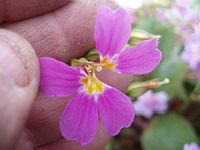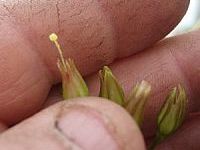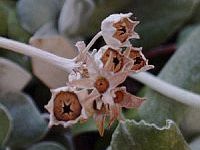
Northern Section
Northern Section
AURICULA FROM SEED
First obtain your seed. This can be sourced from commercial outlets (availability of know crosses limited); the Society seed exchange (restricted to members only) at very reasonable prices; or by producing your own seed from your own plants for free.
As seed does not produce plants that are true to the parents, you will be raising new varieties. Although only about 1% of the seedlings will be of show standard quality and form, the remainder can be given away to friends for growing in their gardens.
The best time to make crosses is around midday on a bright warm sunny day when the pin or stigma becomes sticky and receptive, also make sure the pollen to be used is ripe, a good golden colour and fluffy. If it is a dull colour with a slight grey appearance its past its best and probably no good. The easiest method of pollinating is to carefully tear open the petals with pollen attached (figure 1), to expose the stigma (figure 2) and set them aside. Repeat this for the second plant. Holding the removed torn petal with exposed stamens from the first plant, touch the stigma on the second plant ensuring that pollen adheres, make a note of the cross parents on a label and put this into the pot with the plants you have pollinated. It is also a good idea to tie a piece of twine or wool around the stem of the pips pollenated, just to remind you which seed pods are the actual crosses. Repeat this process with the other plant to give two plants with the same cross. These often produce different results. See video below.



A greenhouse or cold frame is the ideal home for your Auriculas prior to and after pollination. The plants should be kept shaded and cool where possible with good ventilation. Fine mesh over open doors and windows will keep a good supply of air flowing over the plants but more importantly keep bees and other bugs from contaminating your cross with pollen from other plants. Make sure the plants don't dry out as this could stress the plant and prevent seed setting. Once the pods swell and the green cover over the seed pod changes to the colour of straw and cracks across the cover (figure 3), carefully remove the seed pods and place into small paper or glassine seed envelopes (never use polythene bags this can cause rot) clearly marked with the names of the parent plants crossed together with the date. Allow to dry naturally indoors and then seperate the seed from the husks. Return the clean seed to their envelopes and store in an airtight container (an old jam jar is ideal) in the refrigerator, not the freezer, until sowing.
Some members sow the seed in September/October but others prefer to sow it in January/February the following year. Spare seed can be saved for a number of years in the fridge and shared with friends, or sent to the Society seed exchange scheme.
Using small seed trays or pans, sow the seed onto the surface of compost (50/50 peat compost and sand) or Seed Compost, which has been pre-soaked. Cover the seed with a very thin layer of dry sand or vermiculite and cover the tray or pan with a sheet of glass. Keep it away from direct sunlight and germination should take place in a few weeks. Keep the glass on until ready for transplanting, ensuring they never dry out.
In Spring with the seedlings showing their first pair of true leaves, transplant the seedlings into seed tray inserts (40 sections are ideal for very small seedlings), using the same compost. The inserts allow for future potting on to be carried out with minimal root disturbance.
As the seedling grows, use larger inserts and gradually change the compost towards that which will be used for the adult plants.
The final transfer into 7x7x8cm black plastic pots will see them through the winter. Remember to label each pot to identify them.
In the following Spring you should have some of these plants flowering. Now is the time to set aside the good ones and discard those not up to show standard, or give them to friends.
The perfect plant has not yet been produced, and you have as good a chance as anyone to breed the next winner. Good luck.
